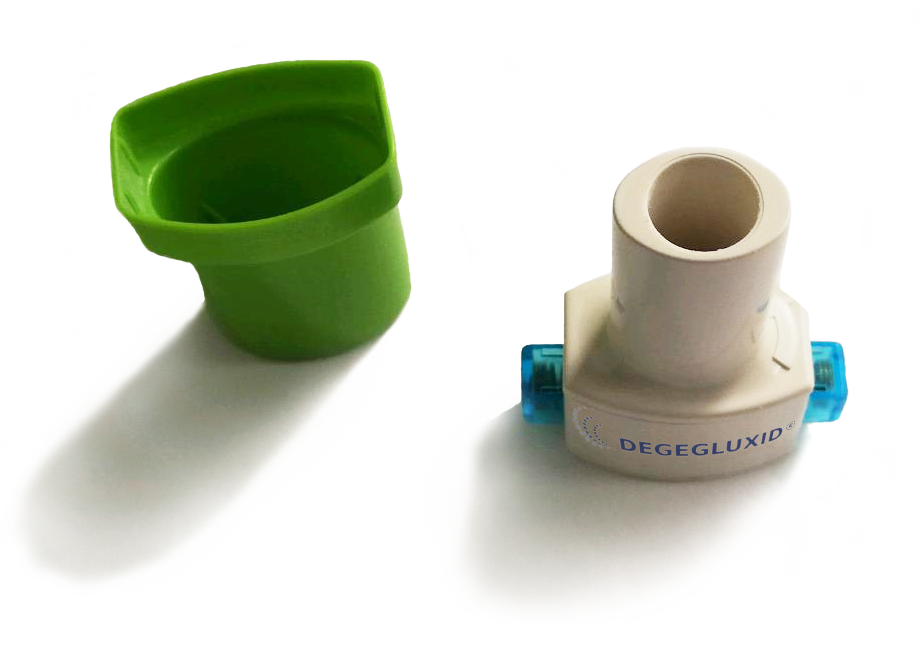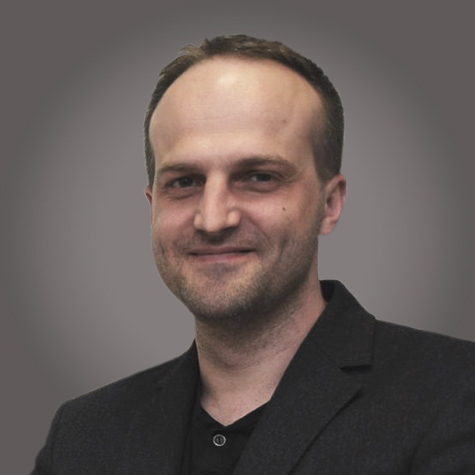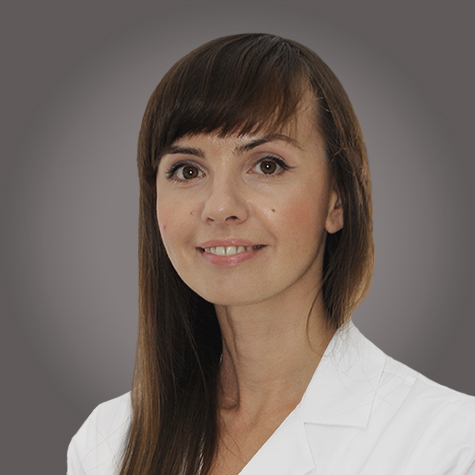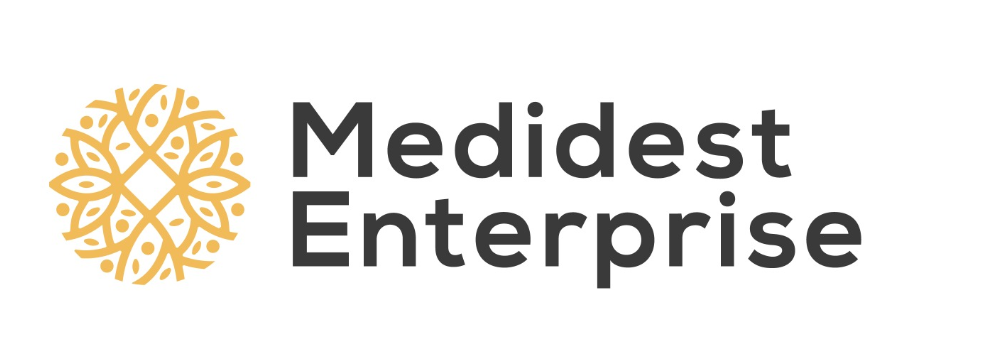That is why, we chose a different approach. A targeted disruption of cell’s metabolism and blocking of the glucose signalling pathways caused a massive reduction in virus production, as well as to apoptosis of infected host cells.
We use the same approach to attack the SARS-CoV-2 viruses (as well as other types of viruses).
We developed an inhalation formulation which contains 2-DG and which enters the airways in the same manner as viruses do. This means that we are able to reach the location (mentioned in numerous studies), which is mostly affected by the infected cells.
We carried out multiple tests on the epithelial cells of the respiratory tract and all of them show the prophylactic as well as the therapeutic effect of 2-DG.
Inhalation has many benefits – it works locally and doesn’t impact the whole organism. Unlike in case of the orally administered formulations, we do not need to apply a 10-times higher doses, in order to obtain a required 2-DG concentration in the lungs. This means that no adverse reactions were observed.
Since a virus strain mutates quickly, it is difficult to develop a long-lasting antidote. We attack the metabolism of the infected cells. This approach always works, regardless of the virus mutation.
For more information we have provided a list of the most popular publications, which support our statements.
1. "DNA Heats Up: Energetics of Genome Ejection from Phage Revealed by Isothermal Titration Calorimetry",
Meerim Jeembaeva, Alex Evilevitch et al.; Journal of Molecular Biology, Vol. 395(5), pp 1079-87.
2. Lai, C.C., et al., Global epidemiology of coronavirus disease 2019 (COVID-19):
disease incidence, daily cumulative index, mortality, and their association with country healthcare
resources and economic status. Int J Antimicrob Agents, 2020. 55(4): p. 105946.
3. Deng, L., et al., Arbidol combined with LPV/r versus LPV/r alone against Corona Virus Disease 2019:
A retrospective cohort study. J Infect, 2020. 81(1): p. e1-e5.
4. Liu, Y., et al., Viral dynamics in mild and severe cases of COVID-19. Lancet Infect Dis, 2020. 20(6):
p. 656-657.
5. Woodward, G.E. and M.T. Hudson, The effect of 2-desoxy-D-glucose on glycolysis and respiration of
tumor and normal tissues. Cancer Res, 1954. 14(8): p. 599-605.
6. Garriga-Canut, M., et al., 2-Deoxy-D-glucose reduces epilepsy progression by NRSF-CtBP-dependent
metabolic regulation of chromatin structure. Nat Neurosci, 2006. 9(11): p. 1382-7.
7. Shao, L.R., J.M. Rho, and C.E. Stafstrom, Glycolytic inhibition: A novel approach toward controlling
neuronal excitability and seizures. Epilepsia Open, 2018. 3(Suppl Suppl 2): p. 191-197.
8. Dwarakanath, B. and V. Jain, Targeting glucose metabolism with 2-deoxy-D-glucose for improving cancer
therapy. Future Oncol, 2009. 5(5): p. 581-5.
9. Simons, A.L., et al., 2-Deoxy-D-glucose combined with cisplatin enhances cytotoxicity via metabolic
oxidative stress in human head and neck cancer cells. Cancer Res, 2007. 67(7): p. 3364-70.
10. imons, A.L., et al., Enhanced response of human head and neck cancer xenograft tumors to cisplatin
combined with 2-deoxy-D-glucose correlates with increased 18F-FDG uptake as determined by PET imaging. Int J Radiat Oncol Biol
Phys, 2007. 69(4): p. 1222-30.
11. Zhao, Y., E.B. Butler, and M. Tan, Targeting cellular metabolism to improve cancer therapeutics.
Cell Death Dis, 2013. 4: p. e532.
12. Raez, L.E., et al., A phase I dose-escalation trial of 2-deoxy-D-glucose alone or combined with
docetaxel in patients with advanced solid tumors. Cancer Chemother Pharmacol, 2013. 71(2): p. 523-30.
13. Kurtoglu, M., et al., Under normoxia, 2-deoxy-D-glucose elicits cell death in select tumor types
not by inhibition of glycolysis but by interfering with N-linked glycosylation. Mol Cancer Ther, 2007. 6(11): p. 3049-58.
14. Stein, M., et al., Targeting tumor metabolism with 2-deoxyglucose in patients with
castrate-resistant prostate cancer and advanced malignancies. Prostate, 2010. 70(13): p. 1388-94.
15. Spivack, J.G., W.H. Prusoff, and T.R. Tritton, A study of the antiviral mechanism of action of
2-deoxy-D-glucose: normally glycosylated proteins are not strictly required for herpes simplex virus attachment but
increase viral penetration and infectivity. Virology, 1982. 123(1): p. 123-38.
16. Leung, H.J., et al., Activation of the unfolded protein response by 2-deoxy-D-glucose inhibits
Kaposi's sarcoma-associated herpesvirus replication and gene expression. Antimicrob Agents Chemother, 2012. 56(11): p. 5794-803.
17. Nakamura, K. and R.W. Compans, Effects of glucosamine, 2-deoxyglucose, and tunicamycin on
glycosylation, sulfation, and assembly of influenza viral proteins. Virology, 1978. 84(2): p. 303-19.
18. Gualdoni, G.A., et al., Rhinovirus induces an anabolic reprogramming in host cell metabolism
essential for viral replication. Proc Natl Acad Sci U S A, 2018. 115(30): p. E7158-E7165.
19. Pajak, B., et al., 2-Deoxy-d-Glucose and Its Analogs: From Diagnostic to Therapeutic Agents.
Int J Mol Sci, 2019. 21(1).
20. Aft, R.L., F.W. Zhang, and D. Gius, Evaluation of 2-deoxy-D-glucose as a chemotherapeutic
agent: mechanism of cell death. Br J Cancer, 2002. 87(7): p. 805-12.
21. Kuna, P., et al., Randomized equivalence trial: A novel multidose dry powder inhaler and
originator device in adult and adolescent asthma. Allergy Asthma Proc, 2015. 36(5): p. 352-64.
22. Schmidt, M.F., R.T. Schwarz, and C. Scholtissek, Nucleoside-diphosphate derivatives of
2-deoxy-D-glucose in animal cells. Eur J Biochem, 1974. 49(1): p. 237-47.
23. Maehama, T., et al., Selective down-regulation of human papillomavirus transcription by
2-deoxyglucose. Int J Cancer, 1998. 76(5): p. 639-46.
24. Wang, Y., et al., Triggering unfolded protein response by 2-Deoxy-D-glucose inhibits porcine
epidemic diarrhea virus propagation. Antiviral Res, 2014. 106: p. 33-41.
25. Bojkova, D., et al., Proteomics of SARS-CoV-2-infected host cells reveals therapy targets.
Nature, 2020.
26. Vijayaraghavan, R., et al., Acute toxicity and cardio-respiratory effects of 2-deoxy-D-glucose:
a promising radio sensitiser. Biomed Environ Sci, 2006. 19(2): p. 96-103.
27. Laszlo, J., et al., The effect of 2-deoxy-D-glucose infusions on lipid and carbohydrate
metabolism in man. J Clin Invest, 1961. 40: p. 171-6.
28. Mohanti, B.K., et al., Improving cancer radiotherapy with 2-deoxy-D-glucose: phase I/II
clinical trials on human cerebral gliomas. Int J Radiat Oncol Biol Phys, 1996. 35(1): p. 103-11.
29. Murugesan K. Gounder, H.L., Mark N. Stein, Susan Goodin, Joseph R. Bertino and Robert S.
DiPaola, Phase I trial of 2-deoxyglucose for treatment of advanced solid tumors and hormone refractory prostate
cancer: A pharmacokinetics (PK) assessment, in Proceedings of the 101st Annual Meeting of the American Association
for Cancer Research. 2010: Washington, DC.
30. Singh, D., et al., Optimizing cancer radiotherapy with 2-deoxy-d-glucose dose escalation
studies in patients with glioblastoma multiforme. Strahlenther Onkol, 2005. 181(8): p. 507-14.
31. Thompson, D.A., et al., Thermoregulatory and related responses to 2-deoxy-D-glucose
administration in humans. Am J Physiol, 1980. 239(3): p. R291-5.
32. Zielinski, R., Fokt, I., Felix, E., Venugopal, R., Arumugam, J., Grela, K., Remiszewski,
M., Skora, S., and W. Priebe. Preclinical evaluation of WP1122, a 2-DG prodrug and inhibitor of glycolysis. in
Proceedings: Symposia on Cancer Research 2017 Cancer Metabolism. 2017. Houston, TX.
33. Kuprys-Lipinska, I., M. Kolacinska-Flont, and P. Kuna, New approach to intermittent and
mild asthma therapy: evolution or revolution in the GINA guidelines? Clin Transl Allergy, 2020. 10: p. 19.
34. Bulbake, U., et al., Liposomal Formulations in Clinical Use: An Updated Review.
Pharmaceutics, 2017. 9(2).
35. Gubernator, J., Active methods of drug loading into liposomes: recent strategies
for stable drug entrapment and increased in vivo activity. Expert Opin Drug Deliv, 2011. 8(5): p. 565-80.
36. Rudokas, M., et al., Liposome Delivery Systems for Inhalation: A Critical Review
Highlighting Formulation Issues and Anticancer Applications. Med Princ Pract, 2016. 25 Suppl 2: p. 60-72.
37. Cipolla, D., I. Gonda, and H.K. Chan, Liposomal formulations for inhalation. Ther
Deliv, 2013. 4(8): p. 1047-72.
38. Kleemann, E., et al., Iloprost-containing liposomes for aerosol application in
pulmonary arterial hypertension: formulation aspects and stability. Pharm Res, 2007. 24(2): p. 277-87.
39. Delgado, T., et al., Induction of the Warburg effect by Kaposi's sarcoma herpesvirus
is required for the maintenance of latently infected endothelial cells. Proc Natl Acad Sci U S A, 2010. 107(23):
p. 10696-701.
40. Stohrer, R. and E. Hunter, Inhibition of Rous sarcoma virus replication by
2-deoxyglucose and tunicamycin: identification of an unglycosylated env gene product. J Virol, 1979. 32(2):
p. 412-9.
41. Datema, R. and R.T. Schwarz, Interference with glycosylation of glycoproteins.
Inhibition of formation of lipid-linked oligosaccharides in vivo. Biochem J, 1979. 184(1): p. 113-23.
42. Gagneur, A., et al., Coronavirus-related nosocomial viral respiratory infections
in a neonatal and paediatric intensive care unit: a prospective study. J Hosp Infect, 2002. 51(1): p. 59-64.
















